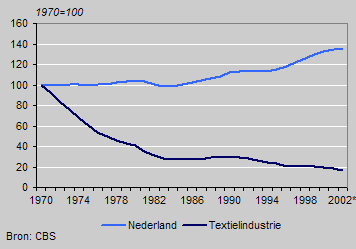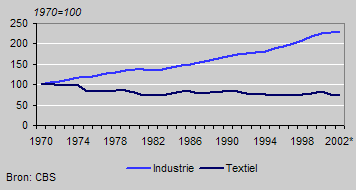The decline of the Dutch textile industry

Unlike most other sectors of manufacturing in the Netherlands, the textile industry has been declining for years. Both the value added and employment in this sector have decreased steadily since 1950.
Economic significance decimated
While the textile industry still accounted for as much as 20 percent of manufacturing value added in 1950, in 2002 this had dropped to 2.3 percent.
The development of employment in the textile industry shows a similar picture. In 1950 it amounted to 223 thousand working years, more than 23 percent of employment in manufacturing. In 2002 this had fallen to 23.5 thousand and 2.6 percent respectively.
Employment (employees)

Shift from the Netherlands to Asia
Employment in the textile industry fell most sharply up to the early eighties. Subsequently there was a period of stabilisation, followed by a further decrease.
In the last few years the clothing industry in particular has been hit sharply. Since 1995 production and value added in this sector have fallen by one third. In the same period (1995–2002) the volume of clothing and shoes purchased by consumers rose by one quarter. Apparently, domestic producers have been ousted in favour of foreign competitors.
Only a few specialised production companies are now left in the Netherlands. With the advent of Asian textile producers, the bulk of the textile industry has moved to the so-called low-wage countries.
Value added

Shift from from Asia to Europe and northern Africa
In the last ten years, a reverse development has set in: textile production is moving from Asia to the low-wage countries in Europe and northern Africa.
The reason for these shifts is the changing consumer behaviour. While in the past there used to be clearly separate summer and winter seasons, today fashions are changing much faster. Young people also have more money to spend. They spend more on clothes and are more fashion conscious.
Shopkeepers react to new trends by changing their collections more often, which means smaller stocks and more sales. Clothes, shoes and fashion wholesalers need to react to these developments very quickly, and therefore opt for short supply chains.
Feike Drost
Source: National accounts of the Netherlands 2002